

Table of contents
- site selection
- Design & shape
- Design with stones
- Choice of herbs
- Sowing & Planting
- Care
- Plant the herb garden - a selection of popular plants
- A small selection of the plants that are at home in many herb gardens:
- Conclusion
Herbs are spicy and tasty, and many types of herbs also have healing effects. With your own herb garden, the menu can be supplemented with hearty herbal plants, which can be harvested if required. Herbs are not only suitable for seasoning food, but also for preparing teas and refreshing cold drinks. When planting a herb garden, the site conditions and the selection of the plants play a major role Herbs play an important role in providing the gardener with a rich harvest over a long period of time can count.
site selection
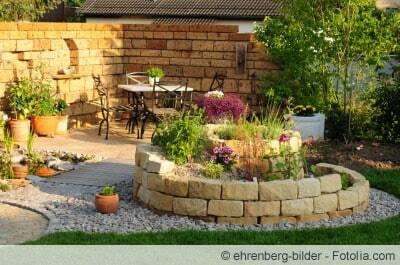
Where the herb garden is laid out is up to the gardener to choose, but certain important requirements should be met. Most types of herbs need a lot of light, so the location should have sufficient sunlight. Some herbs prefer a short-term shady place, this factor can be realized by perennial plants or small trees standing in the immediate vicinity. Which site conditions are preferred depends primarily on the origin of the herb variety. Herbs usually do not need a lot of space and grow and thrive in almost all bed shapes and planters:
- Sunny to full sun places are ideal for Mediterranean herbs
- Native species usually prefer semi-shady locations
- A floor space of about 2-5 square meters is sufficient
- Measure the respective area well before applying
- Pay attention to permeable and nutrient-rich soil quality
- Note the differing demands of the varieties on the nutrient content of the soil
- Divide the herb garden into various zones with different conditions
- Be sure to include the spread, growth habit and winter hardiness of the herbs in your planning
Tip:
Always create the herb garden in the immediate vicinity of the house so that the herbs can be harvested quickly and without much effort.
Design & shape
A herb garden can be perfectly integrated into an existing vegetable garden, but a separate area for the herbs can also be created. There are no limits to the imagination when it comes to design and shape, but certain shapes have proven their worth in terms of care, due to the different requirements of the herbs. These include, above all, the spiral-shaped herb spiral and the practical raised bed. When planting the herb garden, it is always important to ensure that it is not too large and that it is easy to access and walk on from all sides. Natural materials are ideal as a covering for the paths around the bed and between the individual bed sections, which are still easy to walk on even when wet. In addition, the beds can be bordered with shapely stones, practical palisades or a hedge. Low-growing varieties such as boxwood are ideal here:
- Draw a plan before laying, should include the location and size of the area
- Draw beds completely with paths, pay attention to simple concepts
- Plan geometrically simple shapes and reasonable distances
- Suitable materials for the paths: gravel, grit and natural stones
- Classify bed sections according to herbs with compatible site requirements
- Raised beds are easier to harvest
- Designs from the field of rock and cottage gardens are visually very appealing
- Herb spiral with stone surround covers different location requirements
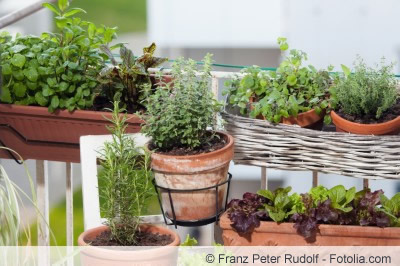
Tip:
With a manageable budget for the design of the herb garden, laying out bark mulch as a substrate for the paths is a good idea. In this way, the herbs are easy to reach even when it rains, without getting your feet wet.
Design with stones
Stones can be used as design elements in the herb garden and serve to separate and protect sensitive herbs. In this way, various sections with different site conditions can be created in the herb bed. Laying out gravel makes the herb garden easier to maintain and can easily be accommodated between the planted areas. In order for Mediterranean medicinal and herbal plants to thrive perfectly, they need a warm and sheltered place due to the local temperature conditions. When cultivating heat-loving herbs from southern European countries, creating a herb spiral has proven itself, which should be in a sunny location:
- Garden wall made of natural stone is the border between beds and other garden areas
- Use stones as a dry wall to limit bed sections
- Use flat stone slabs at a distance as stepping surfaces
- Stone bed with laid gravel prevents weeds from growing
- Use sandstones as protection for Mediterranean herbs
- Light sandstone stores the heat given off by the sun and passes it on to the herbs
Choice of herbs
The range of herbal and medicinal plants is very large, the selection should be based on personal taste and individual preferences. In addition, the intensity of care and the location requirements of the respective varieties must also be taken into account The plants selected should adapt to the local climatic conditions without difficulty can. In order for the herbs to be used regularly, they must be suitable for your favorite foods and drinks. With exotic types of herbs, it is better to try them before planting them, as there are often nasty surprises when it comes to flavor. A distinction is made between annual, biennial and perennial varieties of herb plants, which have different requirements when it comes to care:
- Proven annual herbs: dill, chervil, coriander, cress and marjoram
- Biennial and Perennial Herbs: Basil, Cumin, Lavender, Lovage, Mint, Oregano, Parsley, Rosemary, Sage, Chives, Thyme and Lemon Balm
- Mediterranean herbs are extremely sun-tolerant and also thrive on poor soil
- Mediterranean herbs: lavender, oregano, rosemary, sage and thyme
- Herbs for sunny and semi-shady locations with nutrient-rich soil: dill, coriander, lemon balm and mint
- Varieties for partially shaded, humus-rich and slightly damp places: tarragon, nasturtium, chervil, marjoram, parsley and chives
- Sorrel and woodruff are ideal for shady, humus-rich and moist locations
Sowing & Planting
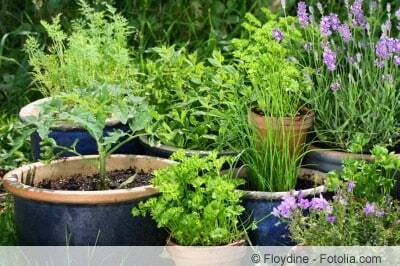
There is now a wide range of seeds and pre-grown young plants available in specialist shops that can be used to create a herb garden. Herbs that are not hardy can only be cultivated in a planter. At the end of autumn, these sensitive varieties have to move to a suitable winter quarters. When sowing and planting, the right time is crucial so that the herbs can grow and thrive without any problems:
- Loosen the soil well before planting
- Spread annual herbs as seeds in the herb garden
- The ideal time for sowing is from mid-May, after the last ground frosts
- Cover freshly sown herb seeds with some garden fleece immediately after sowing
- Initial coverage will encourage germination
- Sow biennial and perennial herbs the previous September
- Alternatively plant as early perennial plants in spring or autumn
Care
If the site conditions are right, the maintenance effort in the herb garden is minimized, so these factors must be observed, otherwise the herb bed will do a lot of unnecessary work. Water the herbal plants either in the morning or in the evening hours when the sun's rays are not yet or no longer in full force. Otherwise, the irrigation water can burn the herbs and cause them to die. The Mediterranean herbs only need a little water and also get along well with nutrient-poor soils, which is why they do not need a lot of fertilizer. With herbs, it is better to refrain from using chemical fertilizers, since they are not only harmful to health, but also negatively affect the taste of the particular type of herb:
- Absolutely avoid waterlogging
- Cover the soil in tubs and pots with a layer of gravel or granules
- Southern varieties cope well with heat and drought
- Native herbs need sheltered places with constant watering units
- Fertilize with compost once or twice a year, either in spring and/or fall
- Water regularly and remove weeds
- Move non-hardy herbs to suitable winter quarters at the end of autumn
- When winter sets in, cover sensitive herbs with fleece or brushwood
Plant the herb garden - a selection of popular plants
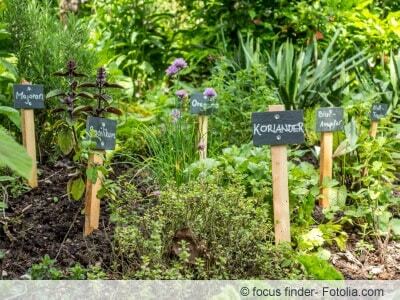
There are many popular garden herbs. Before you start creating a herb bed, you should first ask yourself which herbs are actually often used in the kitchen. In addition to a “minimum stock of herbs”, it is always worth cultivating a few rare herbs. From experience, however, it can be said that the number of herbs that are often used is usually manageable.
A small selection of the plants that are at home in many herb gardens:
- Parsley - Versatile and popular, sown annually or every two years.
- Chives – can hibernate in the herb bed for years.
- Sage – grows into a lush shrub, plan enough space when planting.
- Thyme – goes very well with dishes that contain tomato and peppers.
- Rosemary – likes it sunny, goes well with meat dishes, serves as an ingredient for the popular rosemary potatoes.
- Savory - gives bean dishes the right flavor.
- Dill – goes well with any cucumber salad.
- Peppermint – along with lemon balm, is unbeatable as a tea ingredient.
- Lavender - smells intense and can also be used as a soap ingredient.
- Tarragon - adds a punch to salads.
- Chamomile – popular medicinal plant said to help with stomach problems.
- Basil – Basil leaves are a must on any tomato and mozzarella plate. Danger! Snails like basil too.
Conclusion
A herb garden can be set up quickly and provides dedicated hobby cooks with lots of fresh herbs for the preparation of food and drinks. When choosing the location, the requirements of the various herbs must be observed, otherwise they will wither quickly. With a spiral-shaped herb snail, different site conditions can be simulated in the smallest of spaces in order to be able to plant many different types of herbs. A practical raised bed makes the gardener's work easier and also offers good protection against pests and bad weather conditions. The tangy smell and hearty taste of the herbs are a good reward for the time you put in.
 garden editorial
garden editorial I write about everything that interests me in my garden.
Learn more about herb garden

Build your own herb bed: ideas for classic and modern beds
Herbs from the garden are a welcome and totally trendy thing. They are tasty and healthy as well. So it makes sense to build a herb bed. That can then also be designed in a modern way. There are ideas for this here.
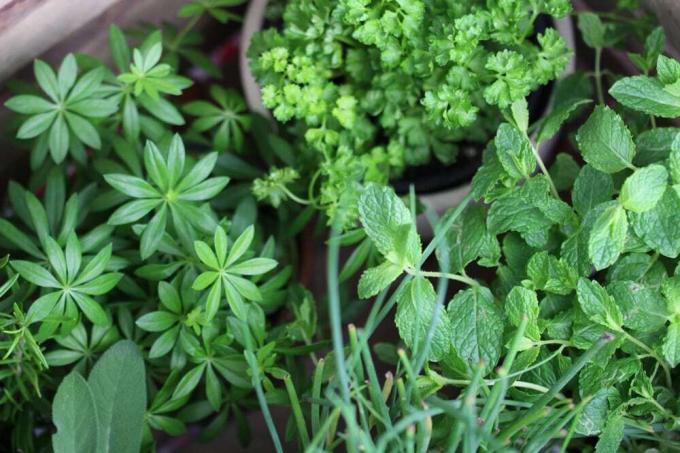
Mortar tub as a plant pot and herb bed
Mortar trays from the well-stocked hardware store are the ideal alternative for quickly and easily on the patio or balcony to conjure up a small herb bed or tomatoes, peppers but also flowering plants cultivate. The tubs are available in different sizes and shapes and thus fit into the smallest corner.

Perennial herbs in the herb garden - list of hardy varieties
Herbs are very popular among hobby gardeners, and rightly so! Because the plants are not only versatile, but also usually perennial and hardy! You can find out here which varieties you should definitely grow in your herb bed!

The best two herb snail building instructions
From the dry zone to the swamp area, the right climate zone for every herb. All of this in just three square meters. With a herb snail, you can create this small natural wonder, a so-called permaculture, in your own garden. There are multiple varieties and appearances and sizes, all of which follow basically the same building instructions.

Creating a herb snail – instructions in 6 steps
With a herb snail, fresh kitchen herbs are always on the table, and they also have a high decorative value in the garden. The attractive herb bed in the form of a spiral grows upwards like a snail and therefore allows the planting of many different herbs with different demands on each Location.
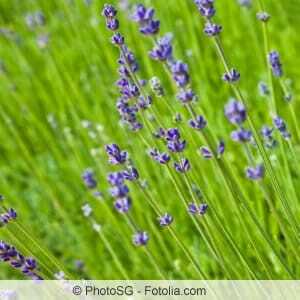
Lavender varieties - hardy species for the garden
Robust, strongly scented and used in the kitchen and as a remedy, everyone knows lavender. But be careful, because not all of the many varieties of lavender are suitable for cultivation in your garden bed at home. Because there are only a few varieties that are hardy and can survive a winter in the local latitudes outside.



